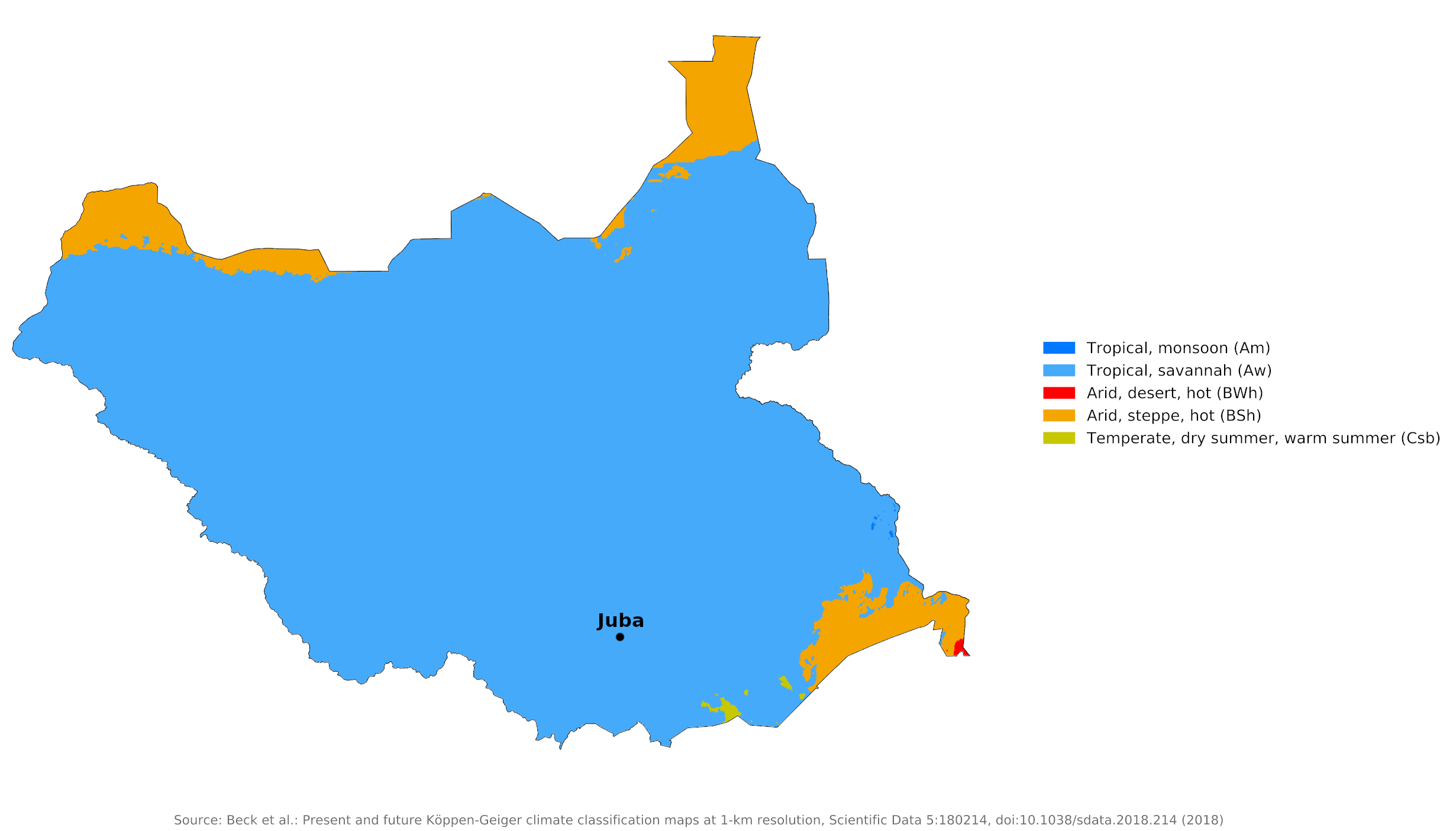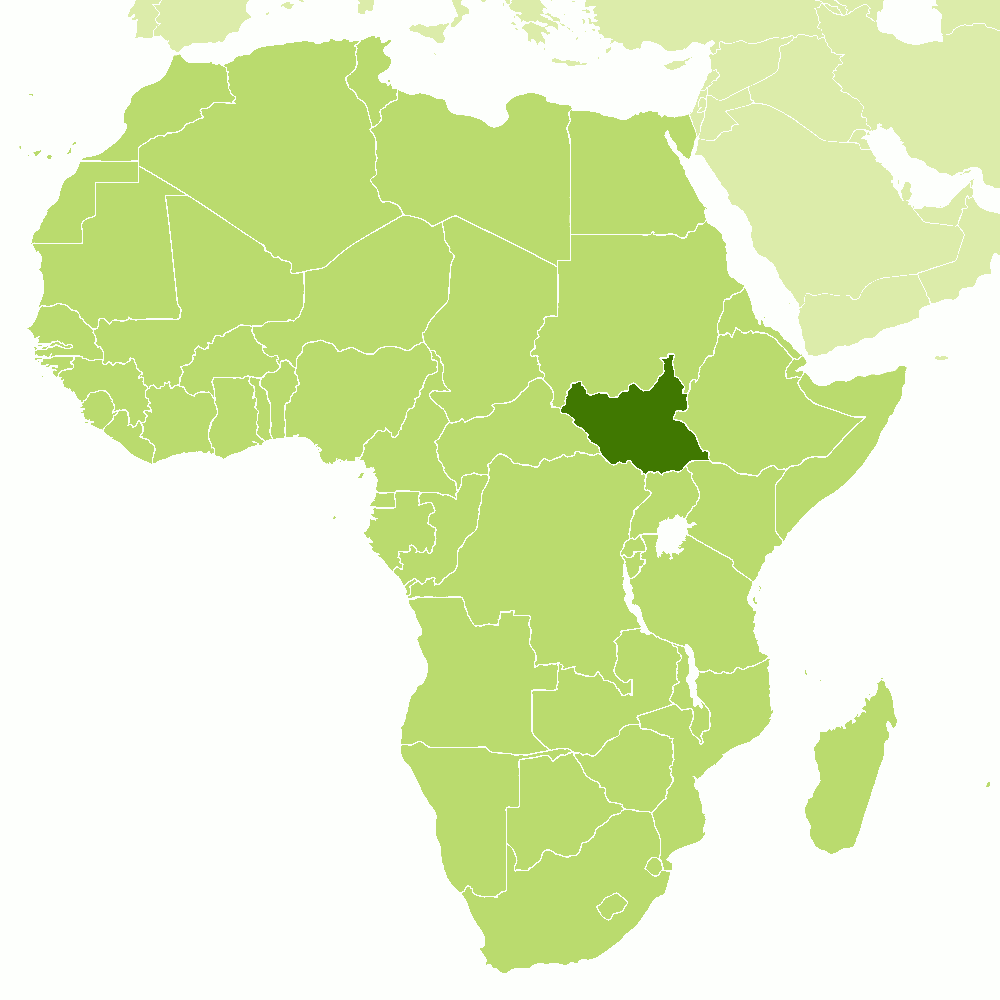The Climate of
South Sudan
 Mountain landscape in the Eastern Equatoria region
Mountain landscape in the Eastern Equatoria region
Climate Map
 Climate map of South Sudan
Climate map of South Sudan
What is the climate of South Sudan like?
South Sudan is a landlocked country in East-Central Africa. It is situated south of Sudan, north of Uganda and Kenya, and west of Ethiopia. The landscape is one of plains in the north and center which rise to southern highlands along the border with Uganda and Kenya. The White Nile, flowing north out of the uplands of Central Africa, is the major geographic feature of the country.
South Sudan experiences a tropical, equatorial climate, with a long rainy season. As it lies near the equator, temperatures are hot year-round. Mean daily temperatures vary from of 30°C (86°F) in March to 26°C (80°F) in July.
Southwards to the southern border there is a progressive increase in the annual rainfall from 500 millimeters (20 inches) to over 1,000 millimeters (40 inches). Rainfall is heaviest in upland areas of the extreme south. The rainy season is almost everywhere the period between April and October, although in the south some rain may occur in any month. The length of the rainy season is around six months in the north and eight months in the south.
From December to March, the country is under the influence of dry northeasterlies, and there is minimal rainfall. By early April, the moist south-westerlies have reached South Sudan, bringing heavy rains and thunderstorms. The flow becomes weaker as it spreads north. In October, the dry northeasterlies begin to strengthen and to push south, and by the end of December they cover the entire country.
Monthly temperatures vary little around the year. Temperatures are the highest at the end of the dry season, when cloudless skies and dry air allow them to soar. During the rainy season, the southerly and southwesterly winds bring slightly lower temperatures, higher humidity, and more cloud. During the rainy season there are spells of dry and sunny weather and even in the wettest areas rain only falls on about one day in three. The higher humidity during the rainy season does not make the lower temperatures any more comfortable.
Sunshine during the rainy season averages six to seven hours a day. During the dry season sunshine averages nine to ten hours a day.
| Climate data for Juba (1971–2000) | |||||||||||||
|---|---|---|---|---|---|---|---|---|---|---|---|---|---|
| Month | Jan | Feb | Mar | Apr | May | Jun | Jul | Aug | Sep | Oct | Nov | Dec | Year |
| Average high °C (°F) | 36.8 (98.2) | 37.9 (100.2) | 37.7 (99.9) | 35.4 (95.7) | 33.5 (92.3) | 32.4 (90.3) | 31.1 (88.0) | 31.6 (88.9) | 33.1 (91.6) | 34.0 (93.2) | 34.7 (94.5) | 35.9 (96.6) | 34.5 (94.1) |
| Daily mean °C (°F) | 28.2 (82.8) | 29.3 (84.7) | 29.9 (85.8) | 28.7 (83.7) | 27.6 (81.7) | 26.5 (79.7) | 25.6 (78.1) | 25.5 (77.9) | 26.4 (79.5) | 26.9 (80.4) | 27.4 (81.3) | 27.5 (81.5) | 27.5 (81.4) |
| Average low °C (°F) | 20.1 (68.2) | 21.7 (71.1) | 23.6 (74.5) | 23.4 (74.1) | 22.6 (72.7) | 21.9 (71.4) | 21.1 (70.0) | 21.0 (69.8) | 21.1 (70.0) | 21.3 (70.3) | 20.9 (69.6) | 20.0 (68.0) | 21.6 (70.9) |
| Average precipitation mm (inches) | 5.1 (0.20) | 11.0 (0.43) | 36.7 (1.44) | 111.5 (4.39) | 129.9 (5.11) | 117.8 (4.64) | 144.7 (5.70) | 127.5 (5.02) | 103.7 (4.08) | 114.5 (4.51) | 43.1 (1.70) | 8.2 (0.32) | 953.7 (37.55) |
| Source: World Meteorological Organization | |||||||||||||
References
- E. A. Pearce, Charles Gordon Smith, (1990) The Hutchinson World Weather Guide, John Murray Press. ISBN 1859863426
- Timothy L. Gall, (ed.), (2003), Worldmark Encyclopedia of the Nations, Eleventh Edition, Thomson Gale
- Federal Research Division, Library of Congress, (2015), Sudan: a country study. Claitor's Pub. Division. ISBN 9780844407500
- Hugh Chisholm, (ed.), (1911), Encyclopædia Britannica, Eleventh edition, Cambridge University Press
The Climate of
South Sudan

In summary:
South Sudan has a hot, tropical with seasonal rainfall. Temperatures are hot year-round. Mean daily temperatures vary from of 30°C (86°F) in March to 26°C (80°F) in June.
There is a long rainy season which last from April to October. Rainfall ranges from 500 mm (20 in) in the north to over 1,000 mm (40 inches) in the south.